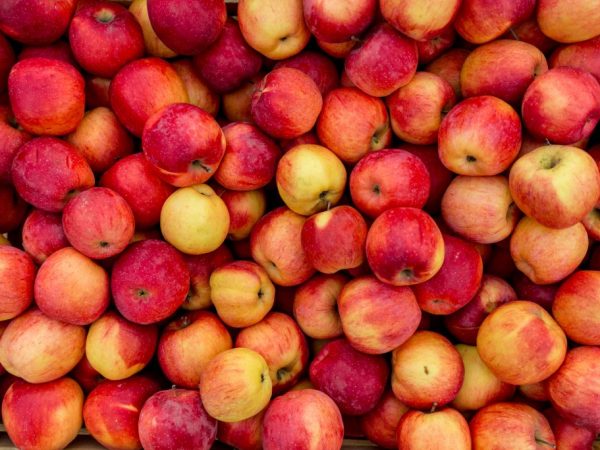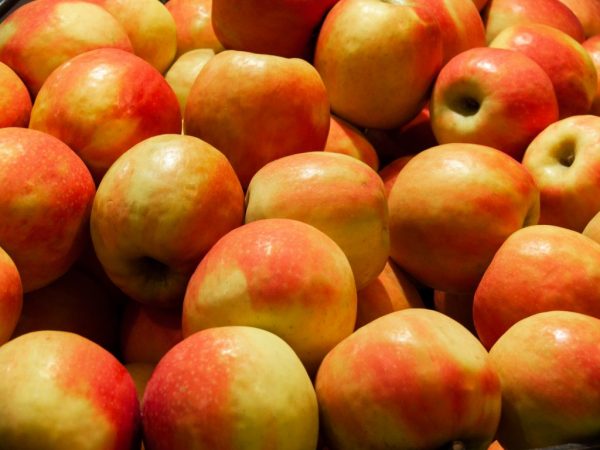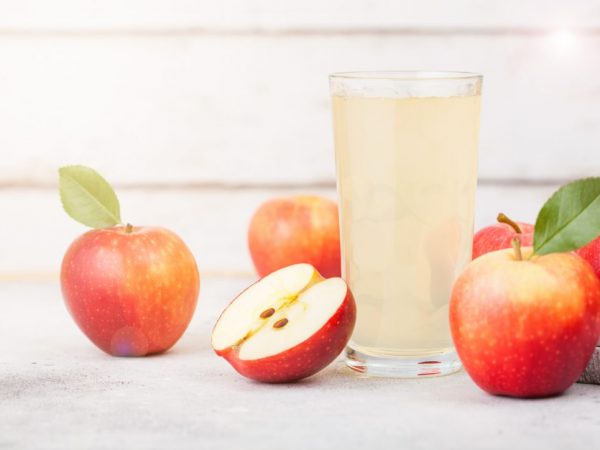Varietal characteristics of the Silver Hoof apple tree
One of the most successful varieties that bear fruit in summer is the Silver Hoof apple tree. It was brought out back in the twentieth century. breeder from the Urals L.A. Kotov. Apples quickly gained consumer confidence and love - they have unusual taste and high resistance to cold.

Varietal characteristics of the Silver Hoof apple tree
Variety characteristic
The origin of the apple tree comes from the varieties Rainbow and Snezhinka. They took her out at the Sverdlovsk selection station. The goal was to create a cold-resistant variety that would later become indispensable.
Description of the tree and fruit
In height, it is medium-sized, sometimes undersized - 2.5-3 m. The crown of the tree is dense and dense. Its shape is closer to round. The branches of the tree are arranged compactly.
Shoots of medium thickness, coffee color. The leaves of the apple tree have a light green uniform color, the surface is matte with an interesting shape (oval with a rounded bottom and a pointed top). The edge of the leaf is serrated.
The description suggests that the flower buds are round, pubescent and medium-sized. The flowers come in a variety of sizes, from medium to large. They are bowl-shaped with loosely set petals.
The apples are medium in size (weighing approximately 90 g), round, one-dimensional. The skin is smooth, matte and loose. The color of the fruit is creamy with a bright scarlet blush.
Yield
Apple tree Silver hoof begins to bear fruit 3-4 years after planting. A good and full harvest will be only from the fifth year.
The variety is considered high-yielding and fast-growing. Ripening occurs more often at the end of summer - in August. If the apple tree was planted in a natural growth zone, the time of harvest comes in September and lasts until October.
Taste
This characteristic of the fruit depends on the age of the tree. For the first 3-4 years, fruits do not contain a spectrum of vitamins and microelements, which affects their taste. In a mature apple, it is rich with a pronounced sourness.
Winter hardiness
The natural growing region of the variety is northwestern, which endowed it with special resistance to cold weather. This determined its main advantage.
Disease resistance
The apple tree has a weak immunity to diseases such as scab, and lack of resistance to various lesions. This greatly complicates the care of the variety and creates the need to cross it with more resistant species.
Landing

The apple tree bears fruit when properly planted
The description suggests that you need to carefully choose a place for a seedling, taking into account important nuances:
- the place should be well lit;
- groundwater should be absent or far from the surface;
- proximity to the pollinator;
- you need to choose the more windy part.
The soil should be chosen with a low acid content or neutral, always breathable.With its low fertility, it is necessary to introduce mineral fertilizers or organic matter. It is worth adding them both in the digging and in the hole in which the tree will be planted.
Both phosphorus compositions and potash, nitrogen and others are suitable. If you have chosen heavy or clayey soil, be sure to backfill the drainage. It can be broken brick or gravel.
You can plant the Silver Hoof apple variety in autumn (September - last weeks of October) and spring (April - May).
You need to take a responsible approach to the choice of seedlings. It is preferable to buy them in specialized nurseries. This will guarantee the purity of the variety. It is better to choose seedlings up to 2 years old. It is important to check the young tree for injuries, undeveloped or broken roots.
Due to the special type of pollination, the planting should be dense. More often, gardeners choose the following scheme: trees are planted every 3 m, and a distance of 5 m is left between the rows.
The pit in which the apple tree is planted must be deep and wide enough. The standard size is 60x70 cm.
For better growth and development of the tree, you need to use a substrate. As a recipe, you can choose the classic one: half a bucket of humus, 1 tbsp each. l. urea and potassium, also add 2 tbsp. l. superphosphate. Pour the substrate to the bottom, put the seedling on top and cover it with earth.
The roots must be well covered and tamped down. The root collar will protrude 5 cm above the soil level. Water the tree immediately using a large amount of water - 5-6 buckets.
Care
An important condition for maintenance is pruning the crown every spring. This will help to form the correct shape and remove unnecessary branches. It is better to use a bush pruning scheme. Such a crown will be better illuminated and ventilated, it will be easier for the pollinator to work.
Watering should be moderate, it should be done several times a month. In a dry summer, it is worth moistening the tree during the garter, flowering. You need to stop watering in the fall, before the onset of frost.
To save on irrigation, mulching can be done. To do this, you need to prepare mulch according to a simple recipe: mix 30 g of ammonium nitrate, 0.5 kg of urea and a bucket of humus and then pour it in a layer of 8 cm over the entire area of the root system.
With a frequency of once a year, it is worth feeding. For this, organic compounds are suitable (dilute chicken droppings or manure with water in a ratio of 1:10). When the first flowers appear, it is worth feeding. Superphosphate (100 g) and potassium (60 g) are suitable.
The main thing is to apply fertilizer only after watering. If you neglect this rule, the tree will get burned.
Reproduction and pollinators
Reproduction of the Silver Hoof apple tree is not the most difficult process, but the details need to be thought out in advance. The tree is self-fertile, so a pollinator variety should grow nearby.
For these purposes, Anis Sverdlovsky's apple tree is grown next to it. Any variety that blooms in May is also suitable for this.
A weak and small crop will be in the absence of a pollinator nearby.
Reproduction is carried out in different ways: by grafting a bud or cuttings, by seeds and by rooting cuttings.
Features of ripening and fruiting

Only a good gardener can grow such apples.
After planting, the tree does not bear fruit at full strength and does not give the best result. It is recommended to pick off the inflorescences to avoid the appearance of fruits. The apple tree should spend more energy on growth and development in the first years of life.
A good harvest can be obtained from the fifth year. The tree bears fruit in full force 6 years after planting.
Flowering begins in early May, and the ripening period for Silver Hoof apples is different for regions. For example, in the Sverdlovsk region, ripening occurs at the end of August. If we take the eastern and western regions, ripeness occurs at the beginning of the month.
The peculiarity of ripening is that the fruits harvested later than the term become translucent.
Lack of flowers and fruits
The variety should not be grown by beginners, because its cultivation is associated with a number of difficulties.
Flowers do not appear on the tree due to the following factors:
- incorrect pruning of the crown. You can accidentally remove fruiting branches;
- the tree has not reached fruiting age;
- the presence of a color beetle. In this situation, the tree should be treated against parasites.
Cases of flowering without fruiting can be explained by these reasons:
- harsh cold weather during flowering. The level of fetal development decreases;
- the wrong choice of pollinating varieties or their absence;
- the presence of broken branches. This happens more often during harvest.
If your goal is to get a high-quality and large harvest, you should pay attention to the above reasons.
Harvesting and storage
Harvesting should take place on time, Silverhoof apples should not be on the branch for too long. Otherwise, they become translucent. Some gardeners prefer overripe apples, but this is a matter of taste. Harvesting times may vary depending on the region.
The harvest is well stored - 1.5-2 months, and if the integrity of the fruits is preserved and suitable conditions are maintained - more than 2 months.
For long-term storage, the humidity level should be at least 90%. The temperature is rather low (less than 0 ° С). The fruits must be packed in wooden boxes. Apples with external damage should be disposed of immediately.
Diseases and pests
The variety is moderately resistant to fungi, but prone to scab and fruit rot.
When fruit rot occurs, cracks and ulcers appear on the apple. The fruits quickly begin to rot and deteriorate. It is important to remove infected fruit on time.
The main disease of the variety is scab. Common causes: poorly trimmed and dense crown, high and constant humidity and dampness in summer, acidic soil, a large amount of nitrogen fertilizers.
As a preventive measure, the best remedy is timely and high-quality pruning of the crown. It is also worth spraying with a 7% urea solution, periodically loosen some of the earth near the trunk.
Some gardeners add lime to the soil. The recipe is as simple as possible: you just need to add 150-200 g of lime per 1 sq. m of soil. Treatment with a 1% solution of copper sulfate is important. Mostly this is done after the tree has flowered.
The most popular parasites on the tree are aphids and moths. It is important to start pest control on time. In the case of the moth, the first generation affects only 20% of the crop, while the second - up to 80-90%. This often causes rot.
Aphids are less destructive, but you should not delay solving the problem. A new generation of pesticides is suitable for both of these challenges.
Growing regions
The advantage of this variety over others is its good cold resistance. He took root well in the Moscow region, which is characterized by both cold winters and dry summers; in the Urals (where it was recognized as the best for cultivation), in the Volga region.
The apple tree of the Serebryanoye Kopytse variety is widespread in the northwest, in Siberia. There frosts drop to -50 ° C.
Gardeners reviews
Separately, gardeners note the long-term storage and appearance of apples, as well as the high yield of the variety. There are a number of reviews about improving the taste of overripe fruits, but this aspect is purely individual.
Among the negative ones, the freezing of trees is distinguished. It is worth noting that after a while they are restored. This period can last from a month to an entire season.

